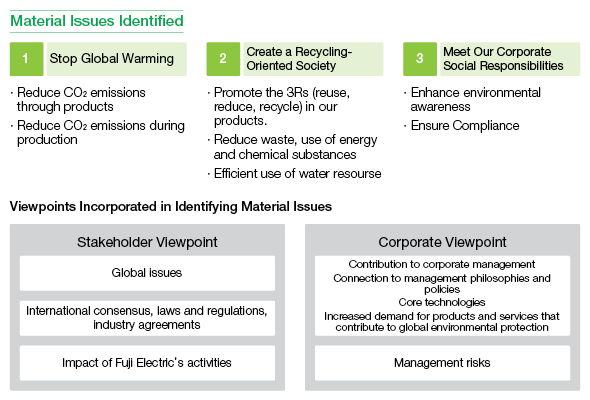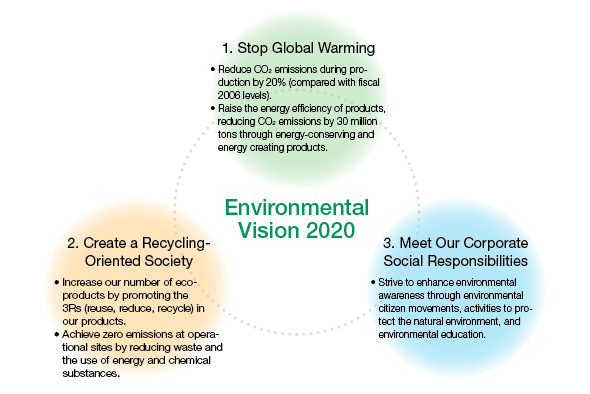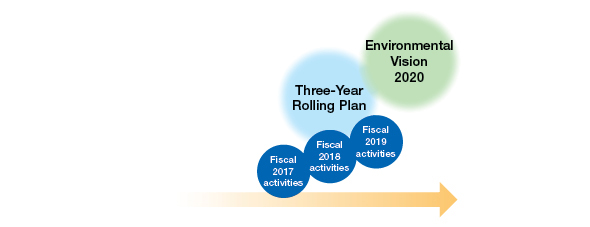Sustainability
Environmental Vision 2020
At Fuji Electric, we establish environmental visions based on our policy of contributing to society by developing our energy-related business globally, and we are united in tackling environmental issues. In addition, we recently set new targets for the reduction of greenhouse gas emissions.
Fuji Electric's Material Issues for Environmental Management
Fuji Electric brought together staff from its management planning, technology development and business divisions to identify and prioritize material issues in promoting environmental management based on our Basic Policies on Environmental Protection, from both stakeholder and corporate viewpoints.
In 2009, we established Environmental Vision 2020 to guide our medium-term activities. The vision sets forth the three important themes below, and establishes specific measures and targets for addressing them.

Environmental Vision 2020
Our Environmental Vision 2020, formulated in fiscal 2009, designates three important issues: stopping global warming; creating a recycling-oriented society; and meeting our corporate social responsibilities. Focusing on these issues, we aim to achieve a sustainable society by reducing the environmental impact of our manufacturing activities, while also using the electric and thermal energy technologies in which we excel to provide products and technologies.
Our main initiatives under the issue of stopping global warming are to reduce CO2 emissions during production by 20% in fiscal 2020 compared with the fiscal 2006 level of 381,000 tons, while reducing society’s CO2 emissions by 30 million tons by expanding sales of energy-saving and energy-creating products.
The cutting-edge technology of energy management efforts realized through CO2 emission reduction activities at our factories will be incorporated into products in order to aid customers in their own CO2 emission reduction activities.
Meanwhile, we continue to address to two major tasks with regard to production materials as part of our efforts for creating a recycling-oriented society. The first task is to realize overall reductions in the amounts of materials and parts used and waste emitted during production activities. In order to accomplish this objective, we will incorporate the 3Rs into product designs to expand our lineup of environmentally friendly products that use fewer resources, are lighter and more compact and efficient, and allow for easy disassembly and recycling of materials. In addition, we will work to reduce the amount of defective products created during manufacturing processes through quality management activities.
The second task is to achieve zero emissions by improving recycling rates. To address this task, we strive to guarantee that waste is properly separated in order to increase the portion of waste that is recycled and thereby work to reduce the amount of waste sent to final disposal to zero.
Our Environmental Vision 2020, formulated in fiscal 2009, designates three important issues: stopping global warming; creating a recycling-oriented society; and meeting our corporate social responsibilities. Focusing on these issues, we aim to achieve a sustainable society by reducing the environmental impact of our manufacturing activities, while also using the electric and thermal energy technologies in which we excel to provide products and technologies. Our main initiatives under the issue of stopping global warming are to reduce CO2 emissions during production by 20% in fiscal 2020 compared with the fiscal 2006 level of 381,000 tons, while reducing society’s CO2 emissions by 30 million tons by expanding sales of energy-saving and energy-creating products. The cutting-edge technology of energy management efforts realized through CO2 emission reduction activities at our factories will be incorporated into products in order to aid customers in their own CO2 emission reduction activities. Meanwhile, we continue to address to two major tasks with regard to production materials as part of our efforts for creating a recycling-oriented society. The first task is to realize overall reductions in the amounts of materials and parts used and waste emitted during production activities. In order to accomplish this objective, we will incorporate the 3Rs into product designs to expand our lineup of environmentally friendly products that use fewer resources, are lighter and more compact and efficient, and allow for easy disassembly and recycling of materials. In addition, we will work to reduce the amount of defective products created during manufacturing processes through quality management activities. The second task is to achieve zero emissions by improving recycling rates. To address this task, we strive to guarantee that waste is properly separated in order to increase the portion of waste that is recycled and thereby work to reduce the amount of waste sent to final disposal to zero. The United Nations Sustainable Development Goals (SDGs), a set of targets to be accomplished by 2030, were agreed upon in 2015, and the Paris Agreement was adopted in December of the same year as an international framework for combating climate change. In light of these developments, Fuji Electric has begun formulating Environmental Vision 2050, its new medium-to-long-term environmental vision.

Environmental Management 3-Year Rolling Plan
To achieve the goals of the Environmental Vision 2020, Fuji Electric has formulated an Environmental Management 3-Year Rolling Plan, designed to promote ongoing efforts.
The objectives of the plan are to verify each year that the environmental management strategy is addressing societal changes, and to establish detailed targets in line with the Fuji Electric Basic Environmental Protection Policy in various areas, such as the enhancement of environmental management governance and the establishment of measures to address the use of chemical substances and prevent global warming. Fuji Electric will continually make revisions to the targets and action plans for each fiscal year up to 3 years in advance, and aim to achieve the goals of Environmental Vision 2020 with certainty.

Establishment of New Greenhouse Gas Emission Reduction Targets
The international society is accelerating its effort to combat global warming from a long-term perspective. This trend can be seen in the adoption of the United Nations SDGs, which put forth goals for sustainable development, and the Paris Agreement, an international framework for combating climate change.
Under the Paris Agreement, countries are expected to strive to limit the rise in average temperature to less than 2.0℃ above preindustrial levels.
Meanwhile, Japan’s Plan for Global Warming Countermeasures targets a 26% reduction in greenhouse gas emissions from fiscal 2013 levels by fiscal 2030 and also contains a long-term target of reducing emissions by 80% from fiscal 2013 levels by fiscal 2050.
Fuji Electric is currently in the process of formulating Environmental Vision 2050, its new medium-to-long-term environment vision, based on these developments. As part of this process, we have set new greenhouse emissions reduction targets.
